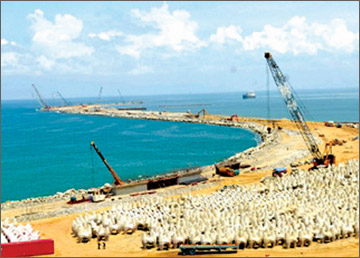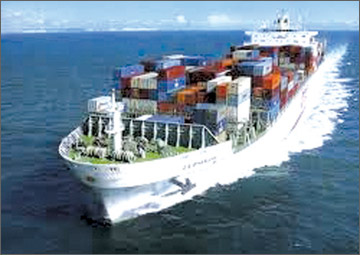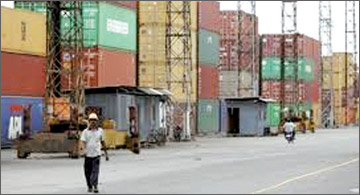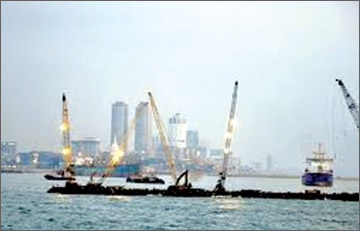|
Shipping review 2011 :
Colombo Port best in region
Sanjeevi Jayasuriya

Colombo South Harbour development in progress |
 |
 |
 |
 |
| The Ruhunu
Magampura Mahinda Rajapaksa Port |
The Colombo Port is the most stable and the best port in the region.
It needs to attract possible business despite the downward trend in the
global shipping industry.
Several mega port development projects launched during the past five
years with US $ 237.1 million invested in 2010. In 2011 the investment
surpassed this figure and included $ 500 million and the third terminal
construction began during the latter part of the year. The port
investment is promoted through public-private partnerships (PPPs) in
port operation and port infrastructure.
It is estimated that private sectors investment is to rise to US $
440 million in 2011 to 2013 and a further US $ 2.8 billion during the
period of 2017 to 2020.
Many shipping lines are comfortable with the services it offers and
the country need to have a strategy to consolidate its position. Sri
Lanka needs to focus on capturing the global market as the Asian
shipping industry is performing better compared to the rest of the
world.
The country expects improved performance from beyond 2010 as
strategically located on the main international shipping routes and
expects to become a naval hub of Asia. The positioning is advantageous
for trade, transport and transshipment activities.
There had been a good growth in container handling and transshipment
during the last five years. Container handling is expected to reach 10
million TEUs per annum by 2020.
The maritime industry including the global shipping lines recorded
heavy loss last year. The global shipping industry suffered heavy due to
the economic downturn and all other sectors related to the shipping
industry. The total output and trade volumes declined drastically.
However, there are indications that the industry would recover this year
with the slowing down of the economic recession.
The country should be mindful of the threats emerging from Indian
ports and needs to be geared to face the challenges. It is important to
complete the Port projects - Hambantota and Colombo South Harbour on
time for future attractions.
Harbour expansion projects and infrastructure to bring bulk vessels
should be completed within the set time frames to derive benefits from
the shipping industry.
The shipping industry in Asia will flourish in the next few years and
Sri Lanka will definitely benefit. The expansion of infrastructure
facilities such as harbour facilities in Sri Lanka will bring in bulk
vessels to the country. This will result in employment opportunities.
The unstable market, trade and charges imposed by carriers have been
challenged with shippers. For shipping lines the imbalance of trade has
become a challenge.
In addressing these issues, the industry should look into fast and
fine technology that will provide end-to-end solutions. The shipping
industry in Asia is facing the lack of a proper regulatory framework
that affects manufacturers and exporters.
The shipping industry contributes to 10 percent of the GDP. Sri Lanka
needs to expand capacity in service levels and to introduce new
technology for further contribution.
The shipping industry in Sri Lanka has been growing even during the
crucial terrorism period as the shipping industry in Singapore too
recorded a growth of 10 percent of its GDP. A proper framework should be
in place for further development of the shipping industry.
Sri Lanka is fortunate to have the Asian Shipper’s Council
headquarters here. The headquarters of Asian Shipper’s Council Training
Academy will also be set up in Sri Lanka soon. It will cater to the
Asian region in developing capacities in the shipping industry.
The labour conditions in the industry has to be developed more
efficiently. Apart from that the legal, regulatory and policy matters
too should be addressed.
Shipping or cargo by sea has played a significant role in the
development of the human society over the centuries. Presently there are
two major types of shipping services: shipload services, which move
goods in bulk for one or more shippers; and liner services, which carry
relatively small shipments of general cargo on a regular schedule for
many shippers. The shipping trade continues to expand, bringing benefits
for consumers across the world through competitive freight costs. Thanks
to the growing efficiency of shipping as a mode of transport and
increased economy, the prospects for the shipping industry’s further
growth continue to be strong.
Shipping is the safest and the most environmentally form of
commercial transport. Shipping is amongst the very first industries to
adopt widely implemented international safety standards. Because of its
inherently international nature, the safety of shipping is regulated by
various United Nations Agencies—in particular the International Maritime
Organization (IMO), which has developed a comprehensive framework of
global maritime safety regulations. IMO is a United Nations Specialized
Agency with its 169 workforce, adopts global regulations on safety,
security, and the prevention and control of maritime pollution from
ships around the world.
The year 2010 was named as the “Year of the Sea Farer” to focus
attention on the importance of shipping safety, maritime security and
the maritime environment in order to emphasize a particular aspect of
IMO’s work. The “Year of the Sea Farer 2010” was organized to provide
the maritime community with an opportunity to pay tribute to sea farer’s
for their excellent contribution to the entire world in enhancing the
global trade.
The “Go to Sea” campaign was established in November 2008 by the
(IMO) in association with the International Labour Organization,
International Chamber of Shipping, International Shipping Federation,
International Association of Independent Tank Owners, International
Association of Dry Cargo Ship-owners and International Transport Workers
Federation to protect the rights of the seafarers and to ensure their
safety, when involved in accidents.
The “Go to Sea” campaign was also launched to inspire a new
generation of seafarers by media activities relating to seafarer’s,
making an awareness program for seafarer training, highlight the
importance of a seafarer’s role, and to honour them.
There are many different types of companies involved in the shipping
industry such as ship owners, managers and agents, container services
and terminals, freight forwarders, and even manufacturers and exporters
who have their own shipping departments and require specially trained
shipping personnel. Although some positions require a degree in a
certain field, the shipping industry does not generally specify
particular disciplines as entry requirements. Many shipping companies
provide in-house and on-the-job training including management courses
and executive development programs. Others may also grant education
allowances for local or overseas courses of study that will help in
career development. Some companies may offer shipboard training to
provide staff with exposure to seagoing operations.
In the early 1970s, with the affiliation of the Ceylon Shipping
Corporation (CSC), a cadet training programme was initiated on the
vessel MV “Lanka Kalyani” where batches of twelve cadets were trained
aboard yearly. Sri Lankan youth were given opportunities to obtain cadet
training with foreign shipping companies, and later proceed to the UK,
India, Australia, or to other Commonwealth countries for their
Certificate of Competency Examinations. It was in the mid 80s that the
government-based NDT Cadet Training Schemes was initiated, and followed
the establishment of Nautical Colleges in the private sector. For the
first time Certificate of Competency Examinations for junior officers
were held in the early 90s, followed by the first Master Mariners
Examination, which was held in the year 2002. These initiatives were
reaching benefits in developing the local shipping sector during the
past five years. Maritime Colleges in Sri Lanka today prepare students
for careers through a content- centered curriculum and a hands-on team
building approach to learning. The structured communities emphasize
responsible citizenship and self- discipline, while maximizing
opportunities for exercising leadership. The Colombo International
Nautical & Engineering College (CINEC), the Mercantile Seamen Training
Institute (MSTI), and the Lanka Academy of Technological Studies are
considered as the pioneer institutions where thousands of students
complete their training successfully as rated and licensed seamen.
Training programmes conducted by these institutions assist students with
training and training equipment in the field of maritime transport.
The utmost measures are being taken to enhance the capabilities of
maritime transport training with the multinational scope in developing
countries. These programmes do aim at improving the conditions of work
and life of ship officers, and increasing the ratings in seagoing
vessels. The Colombo International Nautical Engineering College (CINEC)
in Malabe, established in the year 1990, caters for students to reach
their goals in higher education in the field of Marine Engineering, and
Management.
The maritime experience begins in the classroom with top- ranked
academic programmes. The Mercantile Seamen Training Institute (MSTI),
which is located in a sea front in the city of Galle, creates a vibrant
and active learning community and the best maritime learning
opportunities and experiences for all students.
The area of student programmes provides support for those students
through services and activities. Academic as well as social support is
provided by the programmes.
Whether you need tutoring, mentoring, or just academic guidance,
staff is always available to assist you. Success is the number one goal
for each and every student, providing tools and support needed is vital
for today’s student.
The life in the school is more than lectures, tests, books and
studying. It also encompasses meeting diverse people, experiencing new
and exciting things, developing students’ personal skills and enhancing
interests. Getting involved with every activity will benefit students in
and out of the classroom and will give them memories and experiences
that will last a lifetime. With the completion of the development
activities in the Colombo Port, it will be one of the few ports to serve
large ships, which are at present used frequently in the global shipping
industry.
The current growth level in the regional shipping industry, which
records a continuous growth, has created viable business for
industrialists. Therefore, it is important to address the regulatory
reforms that are necessary to further fuel the growth.
The anti-competitive practices will adversely affect the shipping
community and the rates should not be increased in an ad hoc manner. The
pricing should be similar to that of developed countries and need to
have rationality in the pricing mechanism.
In keeping with the budget proposals certain Acts are amended to
facilitate the process to enable Sri Lanka to become a trading hub. The
respective committees are working on these issues at present.
The construction of the five kilometres Colombo South Port breakwater
project is scheduled to be completed by the end of this year. The
industrialists expect the Sri Lanka Port Authority (SLPA) to complete
the terminal building with an investor partner. The terminal will be
operative by early 2013.
The Mahinda Rajapaksa (Magampura) Port will take a few years to reach
the operational level. The SLPA needs to position it as a friendly and
competitive port to attract businesses. It needs to differentiate and be
innovative to become competitive. There should be an immediate financial
and marketing plan and an awareness building process to ensure
sufficient business is attracted to the port.
The regional ports are competing and the competition is healthy to
improve the level of efficiency. The country needs to do its job right
to bring in business for the country. Sri Lanka could capitalize on its
position on global shipping industry where the country is ranked around
30th among the container ports. It is considered as a main transshipment
hub. The shipping industry is faced with uncertainty as the global oil
prices and the market being imbalanced. The industry sees a lot of major
fluctuations in the freight charges. However, the global economic
recovery will have a positive impact on the shipping industry where Sri
Lanka could benefit from it in the near future. |



